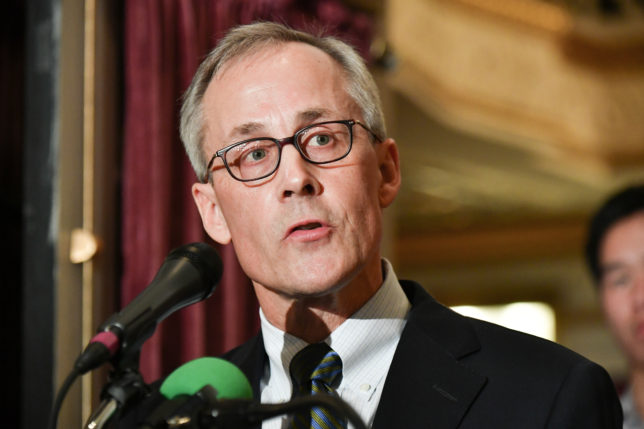
New Chairman of Minneapolis Public Housing Authority (MPHA)
Tom Hoch, a Minneapolis business magnate and the previous CEO of Hennepin Theater Trust, has assumed the position of Board Chair of MPHA. Mr. Hoch served as MPHA’s Deputy Executive Director throughout the 1990’s – a period marked by displacement, demolition and the accelerated privatization of Minneapolis’ largest low-income housing system. As Board Chair, Mr. Hoch brings a deep record of working for – and in most cases, leading – agencies and nonprofits that have (1) consistently moved public assets into private ownership, (2) displaced working-class and BIPOC communities and (3) harassed and jailed homeless and Black youth. The below article details Mr. Hoch’s legacy of disinvesting in Minneapolis’ poor and working class, and the danger he poses to these communities.
From 1984 -1990, Tom Hoch served in a variety of roles at the Minneapolis Community Development Agency (MCDA), the municipal agency which previously existed as a combination of CPED and MPHA. Mr. Hoch coordinated the optic – but not legal – separation of MPHA from the City of Minneapolis,1 and became the newly formed public housing authority’s Deputy Executive Director in 1991. Beyond orchestrating the fake separation of MPHA from municipal government, Mr. Hoch oversaw MCDA’s acquisition of Orpheum Theater in 1988 and the State Theater in 1989. The State and Orpheum theaters would make up two of the three theaters Mr. Hoch’s non-profit would assume ownership of in 2005.
Mr. Hoch’s first stint at MPHA ushered in a new era of austerity, displacement, demolition, gentrification, privatization, and increased reliance on HCVs (Housing Choice Vouchers). In 1992, the NAACP, the Legal Aid Society, and 17 plaintiffs sued local, state and federal agencies, accusing the city of intentionally concentrating and segregating working class families into the Near North neighborhoods by constructing many of the city’s public housing units on the northside of Minneapolis. The lawsuit, Hollman vs. Cisneros, alleged that defendants had intentionally perpetuated and codified Minneapolis’ entrenched racist housing system by weaponizing the city’s public housing authority to segregate and disinvest in the city’s non-white communities. Serving as Deputy Executive Director, Hoch negotiated the lawsuit’s settlement. In an attempt to “deconcentrate” the city’s impoverished communities, the resulting consent decree – the Hollman Decree – led to the demolition of 770 public housing units: Sumner Field Townhomes, Olson Townhomes, Glenwood Townhomes and Lyndale Townhomes.2 Only 88 units were built back in city neighborhoods. Under Hoch’s watch, MPHA expediently demolished the 770 public housing units targeted by the Hollman decree, yet intentionally dragged its feet on locating and creating stable and permanent housing for the displaced. Many families whose homes were demolished either relied on the shelter system for temporary housing or experienced prolonged periods of homelessness. Instead of using his power and authority to advocate for deep investment in Minneapolis’ Black, brown and Indigenous communities, to begin the shift away from decades of racist housing policy, Hoch leveled some of the city’s largest BIPOC communities.3 The displacement of people and families to the suburbs pulled them from community ties and necessary supports; stranding families in areas of unaffordability, few employment opportunities,food desert, and stagnant public transportation systems. Of the 17 plaintiffs in the lawsuit, three families became homeless; three were evicted from their relocation property; and two fell out of communication with MPHA.2
In 1996, Mr. Hoch left MPHA to become the CEO of the Hennepin Theater Trust (formerly the Historic Theater Group). Capitalizing off his role at MCDA and the purchase of the Orpheum and State theater’s, Mr. Hoch’s group incorporated as a non-profit in 2000. Within 5 years, the organization had successfully lobbied the city to transfer ownership of these two theaters, and the Pantages theater, to the Hennepin Theater Trust.4 Across his tenure as CEO, Hoch earned over $2.5 million5 — managing three theaters that previously belonged to the city.
During this time, Hoch became heavily invested in the Minneapolis Downtown Improvement District and the Minneapolis Downtown Council.6 Both groups function as de facto pressure mechanisms serving the downtown elite and wealthy business interests. Hoch served as chair of both boards of the two entwined entities from 2015-2017.7 In 2015, the Downtown Improvement District became the predominant stakeholder in the SafeZone project, a massive surveillance program funded by —and operated on behalf of — the Target Corporation.11 SafeZone, a collaboration between MPD, the Downtown Improvement District and a smattering of social service agencies, is a surveillance program targeting “undesirable individuals”, predominantly unhoused individuals and Black youth.9 Its function is to harass, intimidate and police these individuals out of the downtown area. The Downtown Improvement District also operates the DID “Fusion Center,” a vast array of CCTV cameras and radio communications equipment, out of MPD’s first precinct. The Fusion Center’s main purpose is to actively surveil a list of 100 individuals, dubbed the “DT 100” and relay their movements and status to the police department.11 Ultimately, the program targets poor and Black people, continuously leveling charges of low-level misdemeanor crimes and — with the support and complicity of the Hennepin County attorney’s office— imposes geographic restriction orders for the downtown area. The hyper-surveillance of the SafeZone project effectively criminalizes Black and homeless individuals, intentionally enforcing an increasingly hostile and dangerous downtown area for non-white individuals. Of the “DT 100”, 80% are Black or Native.10
There is no indication that the program slowed or changed course after Mr. Hoch became the board chair of the supervising agency. In fact, Hoch repeatedly alluded to the project, or referenced the underlying racist intentions of the SafeZone project, while on the campaign trail for mayor. Hoch expressed concern that low-income or people “without anywhere to go” threatened the “downtown image.” In an interview with MinnPost in September 2017, he articulated his intentions to ensure downtown Minneapolis remained a haven for wealthy and white Minnesotans only: “Some people are there because they don’t have any place else to be. They don’t have any money. They don’t have any place to go and Hennepin and 1st seem like relatively safe destinations. But it doesn’t make the space feel safe.”12
Hoch now brings this elitist, racist vision for the City of Minneapolis to the most powerful position in MPHA. Why should Minneapolis public housing residents, a majority of whom are BIPOC and/or low-income, feel safe, valued and protected when Hoch’s record has been entirely antithetical to their wellbeing?
Tom Hoch clearly operates solely for the benefit of the Minneapolis elite, massive business interests and the wealthy real-estate lobby. Already, it is clear that he intends to use the position to further the shameless profiteering and intentional disinvestment and criminalization of working-class communities in Minneapolis, and specifically Black youth. During his May 5th confirmation hearing, CM Chughtai asked Hoch if he had any plans to expand access to desperately needed public housing in Minneapolis. Hoch replied, “I don’t know if public housing will be expanding as opposed to affordable housing.”13 Hoch then went on to reference Aeon and Commonbond – two predatory “affordable housing” developers – as the solution to the affordable housing crisis, essentially signaling his intention to accelerate the privatization of MPHA’s housing stock under his watch. Hoch represents everything that is a threat to working-class communities’ ability to thrive — and has built his career off of actualizing these threats. The future of MPHA, according to Hoch, is defined by surveillance, privatization, and the consolidation of capital away from public housing residents.
Sources
- https://mphaonline.org/about/agency-overview-2/history/
- https://conservancy.umn.edu/bitstream/handle/11299/204436/H1026.pdf?sequence=1&isAllowed=y
- https://www.huduser.gov/portal/sites/default/files/pdf/baseline2.pdf
- https://hennepintheatretrust.org/about-us/history-and-background/
- https://projects.propublica.org/nonprofits/organizations/412017278
- https://www.mplsdid.com/news_article/show/475297-tom-hoch-announced-as-mdc-did-board-chair
- https://www.linkedin.com/in/thomas-hoch-949a247
- http://assets.ngin.com/attachments/document/0069/8069/Tom_Hoch_Board_Chair_Release.pdf
- https://unicornriot.ninja/2021/policing-and-punishment-in-minneapolis-safezone/
- https://unicornriot.ninja/2021/minneapolis-downtown-dark-alliance/
- https://www.washingtonpost.com/archive/politics/2006/01/29/retailer-target-branches-out-into-police-work-span-classbankheadminneapolis-forensics-lab-donations-help-law-enforcement-agenciesspan/32273b10-40fa-4db4-a4a1-88b77eafb891/
- https://www.minnpost.com/politics-policy/2017/09/minneapolis-mayoral-candidate-tom-hoch-wants-top-bottom-review-citys-police/
- https://www.youtube.com/watch?v=oUpzHgUakD8&list=PLcNuebgSUruAGjs3a1wgfBmtcdlMjKWTJ&index=17
©Defend Glendale & Public Housing Coalition
July 14, 2022
